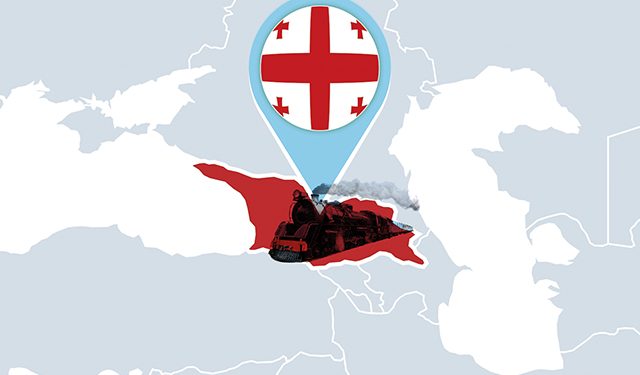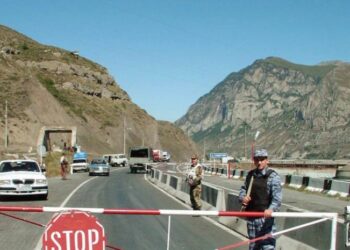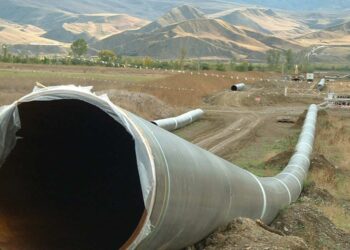As a result of the collapse of the Soviet Union and the restoration of independence, the new subjects of international relations – the former “Union republics” – immediately found themselves in a geopolitical vacuum. In addition to their legal status in the world system, most of them had to prove their state capacity almost from scratch. This process was quite long and very painful – especially for Georgia and its immediate neighbors. Moreover, the heavy Soviet legacy, inexperience in modern governance, and ignorance of the basics of political processes caused serious upheavals in a number of countries. And the “triangle” of the South Caucasus has become a center of constant instability, continuing internal turmoil and fomenting external threats. Thus, it cannot be explained by coincidence that in the first years of our independence, planners of big-league politics turned away from the geopolitical or geo-economic dividends of our region because of the toxicity. This attitude, in turn, increased the destabilization of domestic processes and reduced the competitiveness of the Black Sea and Caspian Sea region. The urgent task was to find ways to take the countries of the region from the periphery of global processes and turn them into a living, meaningful political geography.
Marking out such roads and taking the region out of the post-Soviet “swamp” at the time referred to very noisy applications for transport links, transit corridors and communication networks. In fact, geography became one of the most effective factors in emerging from ultimate oblivion, and the processes derived from this factor actually got a boost of fast action. Over time, transport and communications became a regional calling card, which provided the country participating in this or that project, although with some mistakes, somewhere not completely, and somewhere with some lag, a possibility of national positioning and profitable capitalization.
Obviously, the Georgian national-state space also became an integral part of the overall process – the “Traceca” or the “Great Silk Road”: in some projects, Tbilisi acted as an initiator, in some as a co-initiator. In almost all of them, the Georgian link became a necessary component of the overall chain, without which the theoretical results of any project passing through the region could not be transformed into practical results. Accordingly, Official Tbilisi was also faced with a new reality: with proper cooperation and coordination in the region, a healthy Georgian “self-interest” could be properly and fully obtained. Achieving the necessary balance between regional and its own interests was the task of Georgia’s practical policy then, is today, and will be in the future.
With the difficulty of predicting future decades, compared to the megaprojects of the last century, the present day has become even more loaded with the specificity of the communications linking Asia and Europe. The necessary balancing has turned from a political craft to the art of policy-making, and the post-pandemic impact on the global supply-delivery network and the ongoing war in the heart of Europe have left Georgian and regional politics without a ready-made “guide” to meet the new challenges.
However, despite qualitatively new challenges and unknown paradigms, the cornerstone of the function of Georgia and other countries in the region in the global political ecosystem remains transportation arteries, energy supplies and cross-border communication networks.
From evolution to re-evolution
A few decades is not much in the light of historical upheavals. And if we take into account the multilayered specificity of the region in which Georgia is located, it is not a few. Against the background of regional mega-changes, it is difficult not to proceed to naming various processes, but this time, based on the purpose of the article, we will continue to focus only on the transport and communication themes.
Together with a number of key actions of political and economic nature that have had a cardinal impact on the positioning of the Georgian case, cross-border projects passing through the Georgian space have organically connected our country with the regional and foreign economic space. Much has been written about the main oil and gas pipeline projects and there is nothing new to say here, except for one thing: these projects have changed the external position of our country for the better and they will influence the reshaping of internal relations as well. Efforts made in the 1990s and major projects launched since then (railway-land, etc.) have added necessary functional and practical advantages to Georgia’s participation in the eyes of others.
As a result, we went from user to contributor: Sometimes completely and sometimes relatively moderately. But importantly, and most importantly, not only did we retain the function, but the country got its voice in the foreign arena and was able to project its interests in terms of security and economic benefit, which is an even greater result of this functional co-participation. And at this stage the projection of the national interests of the Georgian state developed with relative success and is still developing, although this is already a subject of a separate discussion.
The fact is that the regional specificity noted above has allowed in a relatively short time to transform into a concrete result of this or that pleasing to the ear undertaking or initiative. This is especially evident in the spheres of transport and communication. In this regard, the Middle Corridor megaproject is no exception, quite objectively taking its unique place.
Middle Corridor: What We Know
This project is considered one of the initiatives that aim to connect the West and the East in a better, more efficient and reliable way. Discussions around the Middle Corridor have already progressed to the stage of practical solutions, the tangible result of which will be to link China, Central Asia, South Caucasus (Azerbaijan and Georgia), Turkey and Europe with an interconnected transport space to ensure safe and commercially profitable freight traffic.
It is noteworthy that one source contrasts the Middle Corridor project with the so-called “One Road and One Belt” initiative. In fact, however, the Middle Corridor and the Belt are in some ways complementary. Here, perhaps, one should look for the so-called contradiction elsewhere. In particular, there are several variants of the land-based version of the One Road and One Belt initiative (there is also known to be a maritime version). Although these options are not necessarily mutually exclusive, and connecting Asia to Europe via the Middle Corridor is “one of” the options.
It is clear that all options for a “belt” connecting two geographies of this scale are considered by different geopolitical or geoeconomic actors from their own perspectives. Moreover, from the point of view of Georgian interests, the Middle Corridor bears a completely unique and special load. That is why we specifically said “in some ways complementary” and “one of” for Georgian readers, because in the context of our country’s medium- and long-term interests, the Middle Corridor is actually neither “complementary” nor “one of”. For Georgia’s sustainable and competitive development, the Middle Corridor project is unconditionally the only one and has no alternative.
There are several factors that contribute to this framing of an issue, which we will discuss in the chapter on Middle Corridor Challenges. It may seem strange, but the importance of a project is best seen against the backdrop of related problems and controversies. Thus, we will discuss the role of the Middle Corridor based on this approach.
The tasks of the project are multilayered and multifaceted. Despite their abundance, we believe that they can still be classified according to general characteristics. And, since we intend to make a classification, we will divide the Middle Corridor implementation challenges into three main groups, each of which is either (1) directly related to technical operation, (2) related to the competitive environment, or (3 ) caused by a complex security situation.
Operational and Technical Challenges
Bringing a geography of this scale and area into a unified transport belt depends not only on a declaration of political will. It is clear that the success of the project as a business requires the streamlining of many operational aspects and technical nuances.
The main challenge, from this point of view, is to create an interoperable and synchronized business ecosystem across the corridor. And it involves monumental work, if we remember that the corridor stretches across several large, medium or small, politically-culturally and socio-economically different countries. According to the current version of the Middle Corridor, the project covers the land borders of five states, at least one and at most two seas, which requires harmonization of relevant procedures, norms and standards.
In addition to harmonization of standards for uninterrupted transportation, it is no less challenging to maintain appropriate infrastructure. In this regard, the countries of the Black Sea and Caspian Sea have an additional opportunity to integrate more closely into global economic structures by creating a favorable business environment in the region. It is also indicative that the result of such integration will be the improvement of internal economic relations in this or that country, including Georgia, increasing the competitiveness of the national economy and improving the quality of life of the average citizen.
In order to ensure that all this does not remain an insurmountable challenge, it is also critical to ensure proper transparency of the Middle Corridor project. For this purpose, quite concrete measures are the development of preferential tariffs for the entire route and their unification, the establishment of regulatory framework standards for different carriers, appropriate coordination to establish optimal transportation times, etc.
Here we should also add that to ensure a unified business ecosystem of the Middle Corridor, the countries participating in the project are required to join efforts at the supranational level to attract more cargo flows from China. As cargoes of Chinese origin equal to the vitality of any artery of the Belt, by transferring the flow to the Middle Corridor as much as possible, this project will acquire much greater operational capacity.
To ensure the carrying capacity of the Middle Corridor, the timely and full implementation of one of its key components – the Baku-Tbilisi-Kars railroad – should also be emphasized. The importance of this rail line in the overall context of the megaproject explains the recent announcement of official Baku to invest additional 100 million U.S. dollars, which will probably invalidate the excuses about lack of funds. Such demonstration of Azerbaijan’s readiness should be sufficient motivation for the Georgian side to fulfill its obligations. In short, the Baku-Tbilisi-Kars direction for the Middle Corridor is so unique that shifting the blame between the parties here is, to put it mildly, inappropriate.
Competitive Environment
Just a few years ago, speaking of the competitiveness of the Middle Corridor, we would have said that this route was significantly inferior to the so-called northern route (from China through Russia and, therefore, bypassing the South Caucasus) and was still probably in competition with the southern route (from China through Iran and Afghanistan and here too – bypassing the South Caucasus).
Today, the situation has changed dramatically, to such an extent that the competition factor has sort of lost its relevance. However, the pulse of global processes will keep supporters of the Middle Corridor, including the Georgian side, in constant readiness for possible changes for many years to come. This is not surprising if we remember the high instability and unpredictability of geo-processes.
One way or another, it is a fact that in early 2023, the Middle Corridor “beat” its competitors due to a number of circumstances.
One is the attempt to rearrange the global delivery and supply network in the post-pandemic economic structure. The fact is that the sudden effect of the pandemic created the need to diversify this network, which was to reduce the West’s dependence on unpredictable or, in Western terms, unfriendly countries.
The United States and Europe, in some places because of legislative and in others because of financial measures, were determined to “move away” from risky geographies and to keep the production base as close as possible. This was especially true for such commodity nomenclature, which conditioned the resilience of this or that country in a crisis economy. As a result, it became necessary to identify routes along which the delivery of goods would be free from “blackmail” or “ideological” overtones.
The growth of the Middle Corridor perspective was also particularly facilitated by the withdrawal from the global economic structure of the key player in its most competitive northern route, Russia, which was sanctioned because of the re-invasion of Ukraine. However, the northern route was already well-proven and the shortest route for transporting Asian goods; And, despite considerable congestion during the pandemic, it offered the market optimal services both in terms of price and time. Added to this was the fact that against the background of aggression in Ukraine, any Russian “business offer” was actually tied to Russian foreign-military tasks, which made doing business as usual virtually impossible for a certain category of cargo carriers.
The so-called southern route was practically doomed to the negative effect caused by the sanctions, from which it could be saved only by the renewal of the agreement on Iran’s nuclear program (hypothetically).
Moreover, the southern route, blocked by the Iranian factor, was additionally burdened by the challenge posed by Taliban Afghanistan. And this created an insurmountable obstacle to the movement of a large flow to Europe through the southern route, and an additional advantage to the Middle Corridor.
The geopolitical advantages that emerged have obviously made it more urgent to mobilize political and financial capital to implement the Middle Corridor, as well as to solve the operational problems mentioned in this article. The window of opportunity opened by the war and pandemic has forced Georgian politics to act more proactively to reactivate a solid (and in the foreseeable future, irreversible) role for our country’s renewed historical functionality. At one time seen as an apparently profound theory, the Middle Corridor project and Georgia’s participation in it became a tangible reality.
Read Part 2.
By Victor Kipiani, Chairman of Geocase














